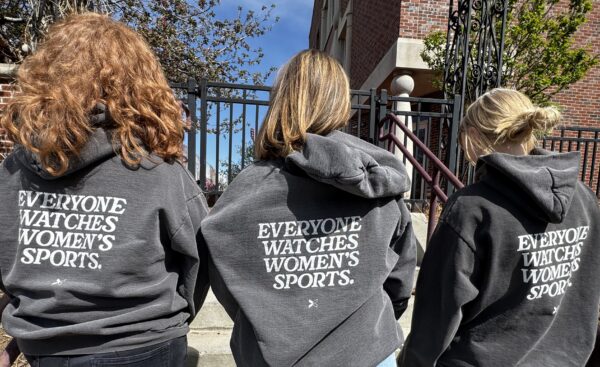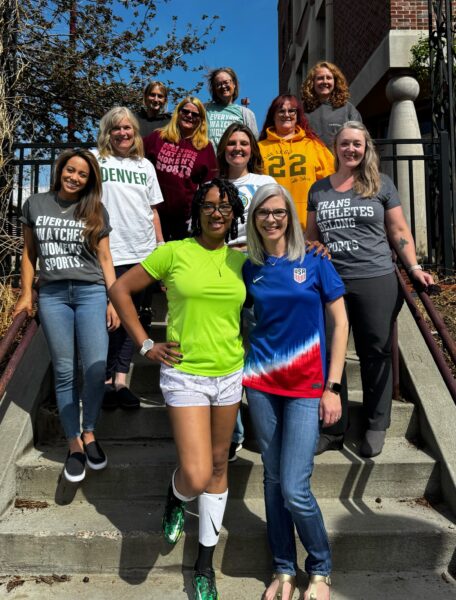
The Rise of Women’s Sports and the Vital Efforts to Continue Their Success
Why We Must Keep Showing Up for Women’s Sports, Today and Every Day
Delaney Lindner joined The Women’s Foundation of Colorado as the Digital Marketing & Communications Intern in January 2025. Growing up in Minnesota, the “State of Hockey,” Delaney brings her team spirit and dedication to supporting women’s prosperity and gender equity. She believes that when women thrive, we all thrive, and envisions a Colorado where women are respected and appreciated in all facets of life.
With Women’s Sports Growing Faster Than Ever, Protecting Progress is Crucial
Four years ago, I watched some of the nation’s best women hockey players take the ice in a small, thinly populated arena in Minnesota to play for a league offering unlivable wages and minimal player benefits. This past February, I watched some of those same players lead Professional Women’s Hockey League (PWHL) teams at Ball Arena with 14,018 fans in attendance— one of the largest U.S. crowds for the league yet. Ecstatic fans flooded the stands, wearing official team jerseys, holding homemade signs high, and smiling with pride as they watched women hockey players finally able to pursue the game as full-time careers. Where players used to make at maximum $15,000 per year in 2021, PWHL players now make at minimum $35,000, finally being compensated more fairly for their talents, but there’s a long way to go.
player benefits. This past February, I watched some of those same players lead Professional Women’s Hockey League (PWHL) teams at Ball Arena with 14,018 fans in attendance— one of the largest U.S. crowds for the league yet. Ecstatic fans flooded the stands, wearing official team jerseys, holding homemade signs high, and smiling with pride as they watched women hockey players finally able to pursue the game as full-time careers. Where players used to make at maximum $15,000 per year in 2021, PWHL players now make at minimum $35,000, finally being compensated more fairly for their talents, but there’s a long way to go.
As someone who grew up playing hockey since I was a little girl, the rise of women’s sports has been a topic close to home. I still remember my youth hockey days, when I had memorized every word to Miracle on Ice and my biggest dream was to play professional hockey. Today, I thank the many generations of women athletes who fought long and hard to turn dreams into reality for me and other girls. Women’s sports continue to grow in popularity and support each year, and it’s nothing short of inspiring to watch their hard-earned success.
Everyone Watches Women’s Sports
In recent years, professional women’s sports have gained more traction, support, and viewership than ever. In just 2024:
- The Women’s National Basketball Association (WNBA) surpassed viewership records with 22 regular season games averaging over 1 million viewers.
- The Pro Volleyball Federation (PVF) announced a multi-year extension of its national TV deal with CBS Sports.
- The Professional Women’s Hockey League (PWHL) brought nearly 400,000 fans to arenas.
- The National Women’s Soccer League (NWSL) earned over 2.5 million championship weekend viewers. It also announced this year that a Denver team will be added to the league in 2026, and two months after the announcement, Denver NWSL had already sold over 10,000 season ticket deposits!
The Growth of Women’s Sports
Clearly, people are watching, supporting, and rooting for women’s sports now more than ever. While their rise can be attributed to the longtime trailblazing work of relentless advocates and athletes, many credit their recent success to increased exposure, both from fans  and media. We’re seeing fans attend games in record numbers and engage on social media with women athletes more than ever. Many media entities, particularly large players such as ESPN, are also beginning to view women’s sports as a valuable part of their assets.
and media. We’re seeing fans attend games in record numbers and engage on social media with women athletes more than ever. Many media entities, particularly large players such as ESPN, are also beginning to view women’s sports as a valuable part of their assets.
The industry’s 300% growth over three years has caught the attention of investors as well, with companies like AT&T, Deloitte, Capital One, and Cisco all uniting to invest in women’s sports in 2024. Tennis icon Serena Williams is even an owner of the WNBA’s Toronto Tempo. Investments like these allow leagues to expand the number of teams they house, increase salary caps, and improve operations.
It’s Been a Long Time Coming
Many of the women’s leagues we know and love today were founded less than 30 years ago, despite women’s involvement in sports dating back to ancient times. Here’s a look at how long women have been waiting:
- The WNBA began play in 1997, 51 years after the NBA
- The NWSL hit the field in 2013, 20 years after MLS began
- The PWHL took the ice in 2024, 107 years after NHL players did
Many of these associations tried for years to sustain leagues before finally securing the funding and investments they have today.
Women’s Sports Still Have a Long Way to Go
Despite the massive growth that women’s sports have seen in the past few years, they still do not receive adequate financial or media support, and a lack of discrimination protections remains prominent in the industry.
Today, 58% of women athletes make less than $25,000 each year from their sport— barely half of the median individual income in the United States ($48,060). Additionally, while some major companies are beginning to invest further in women’s sports, only 6% of Fortune 500 companies sponsor professional women’s teams while 20% sponsor men’s teams, and these funding gaps show in player salaries. Financial barriers for women’s sports extend into collegiate leagues as well. In 2020, men’s college sports programs still received more than double the allocated resources that women’s programs did.
Additionally, while U.S. women’s sports make up nearly half of the competitions played in the country, they only receive 15% of total sports media coverage. This not only limits the reach of the industry but also stunts fan engagement and league revenues.
Alongside a lack of financial support and media coverage, women’s sports remain challenged by discrimination issues that directly impact athletes. Attacks on transgender women in sports have become more severe in recent months after President Trump signed an executive order to ban trans girls from playing girls sports in school. After this order was signed, The National Collegiate Athletic Association (NCAA) followed suit and banned trans women from collegiate athletics, reversing a previous policy that allowed trans women to compete after a year of testosterone suppression treatment. Attacks like these purposefully build barriers to opportunity for gender-expansive individuals in sports.
Women, Athletes, Changemakers
For generations, women have advocated for changes to these inequities. Here’s a fraction of notable moments when women athletes stood up for change in their sports:
- 1973: Because of Billie Jean King’s (a past WFCO Annual Luncheon speaker) advocacy, the U.S. Open became the first major tennis tournament to offer equal prize money to both sexes.
- 2007: Venus Williams pressured Wimbledon to award equal prize money to men and women athletes and succeeded.
- 2017: The U.S. Women’s National Hockey Team successfully threatened a boycott of the world championships and forced U.S.A. Hockey to increase their wages.
- 2019: The United States Women’s National Soccer team sued the U.S. Soccer Federation for gender-based wage discrimination, which the team settled in 2022 for $24 million.
- 2019: Nike announced that it would waive performance-based pay reductions for a 12-month period for those who have a baby, following the advocacy of Olympic athlete Allyson Felix (also a WFCO Annual Luncheon speaker).
It’s dedicated advocacy like this that has brought women’s sports the respect and resources that they hold today, but the work is far from over. Despite the explosion of viewership and support in recent years, women’s sports still come second to men’s in salaries, media coverage, player rights, and more. It’s vital that we continue to advocate for the advancement of women’s leagues and for equitable treatment of women in sports across the country.
Join the Movement
It’s exciting to see the progress. Let’s keep showing up for, cheering for, and supporting this movement that is long overdue. Everyone watches women’s sports. Do you?

Here are a few ways you can make a difference for women’s sports:
- Follow women athletes on social media. The best way to learn about the struggles and successes facing women in sports is directly from the athletes experiencing them.
- Go to a game or watch one! In 2026, show your support for Denver’s new NWSL team by heading out to the field. In the meantime, PWHL games are free to watch on YouTube!
- Join a local women’s team. Local leagues are a great way to get active and meet like-minded women athletes. Check out this list of Denver adult sports leagues here.
- Support women’s sports foundations and nonprofits. These organizations focus on creating opportunities for women and girls to participate in sports. Girls on the Run and Soccer Without Borders are just a few that we love!
- Lastly, buy a ticket, table, or sponsorship to our Annual Luncheon featuring Abby Wambach, captain of FIFA Women’s World Cup champion team, two-time Olympic Gold medalist, and one of TIME Magazine’s “100 Most Influential People in the World.”

